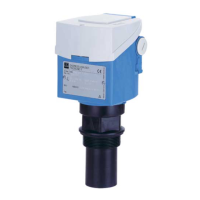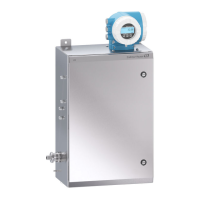TOCII CA72TOC Installation
Endress+Hauser 19
Preparing the stripping reagent
Stripping reagent dosing is regulated via the pH sensor. The regulation range of the dosing is from
the minimum feed rate of the acid pump to approximately 1000 times this amount. The necessary
acid quantity varies greatly from measuring place to measuring place. Ideally, the strength of the
acid in the feeder tank should be set in such a way that the system can regulate in both directions,
but the regulation range should be higher for higher volumes of acid dosed.
Regulation aid:
The acid feeder is typically in the region of a few % acid. The aim should be to achieve a feed rate
of 2 to 5 % for pump P3 (the current feed rate can be read in the
PROGRAMMING/TEST/OUTPUT/PUMPS menu).
To set the acid concentration, an acid is prepared as follows as the starter point:
• Fill the acid hose
• Start measuring operation with a real sample
• Allow the acid dosing system to regulate
• Feed rate > 2 % < 5 %, note the acid concentration and use for future mixtures
• Feed rate < 2 % acid concentration, dilute preparation
• Feed rate > 5 % acid concentration, increase the concentration of the preparation
• Replace the contents of the acid hose
• Allow the acid dosing system to regulate, read off the feed rate
Use of other acids
• Nitric acid
Nitric acid does not form lyophobic salts in the strip chamber. The resulting nitrogen oxides in
the combustion gas are filtered out with an acid filter upstream from the IR detector.
• Phosphoric acid
Phosphoric acid is a low-volatility, odorless acid that generates practically no precipitate. After
combustion, substances are formed that are filtered out completely in the heatable salt trap.
• Sulphuric acid
Sulphuric acid is a low-volatility, odorless acid. When using sulphuric acid, precipitate can be
expected with alkaline earth metal ions. In addition to the sulfur dioxides, salts also occur as a
reaction product downstream from the furnace. These salts are easily removed in the heatable salt
trap. Gypsum can also occur if the water is very hard.
• Hydrochloric acid
Hydrochloric acid is a volatile acid with a pungent odor. Salts do not precipitate in the strip
chamber. During combustion, salts occur (heatable salt trap) as does HCl gas, which is absorbed
in the condensate.
3.4 Post-installation check
• After installation, check that all connections are tightly fitted and are leak-resistant.
• Check all hoses for damage.
Deionized water (ml) HNO
3
25 % (ml) HNO
3
concentration
Increase concentration 500 + 125 5.0 %
+ 125 8.3 %
+ 125 10.7 %
+125 12.5 %
Dilute 500 +125 5.0 %
+ 500 2.8 %
+1000 1.5 %
+2000 0.8 %

